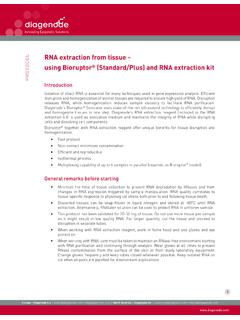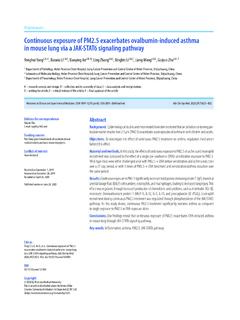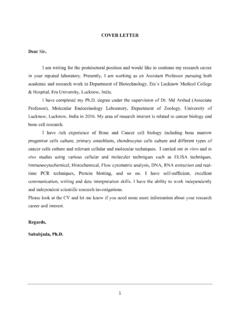Transcription of Protein extraction from Tissues and Cultured Cells using ...
1 PROTOCOLE urope - Diagenode / / // North America - Diagenode Inc. / / extraction from Tissues and Cultured Cells using Bioruptor Standard & PlusIntroductionProtein extraction from Tissues and Cultured Cells is the first step for many biochemical and analytical techniques (PAGE, Western blotting, mass spectrometry, etc.) or Protein purification. Efficient disruption and homogenization of animal Tissues and Cultured Cells are required to ensure high yields of proteins. Diagenode s Bioruptor uses state-of-the-art ultrasound technology to efficiently disrupt and homogenize Tissues and Cultured Cells in just one step. Bioruptor offers unique benefits for tissue disruption and homogenization: Fast and simple No contamination between samples Efficient Gentle processing Reproducible Temperature controlled Multiplexing capabilityGeneral remarks before starting Conditions for Protein extraction ( use of fresh or frozen tissue , composition of extraction buffer etc.)
2 Must be adjusted according to the nature of the proteins of interest and the assays to be run. SDS might be added to the extraction buffer to maximize the yield of soluble proteins. SDS extracts can be used for SDS electrophoresis and Western blotting. It is recommended to reduce the SDS concentration for 2D electrophoresis, enzyme-linked immunosorbent assay and mass spectrometry. For functional studies ( the study of Protein Protein interactions), avoid using ionic detergents and high concentrations of buffer: use RIPA buffer as a starting point for optimization:50 mM Tris-HCl (pH ) 150 mM NaCl 1% NP-40 Na-deoxycholateProtease Inhibitor Mix SDS - 2% (optional)It is always recommended to optimize the buffer composition depending on a specific research project Always use Protease Inhibitor Mix during extraction procedure to block the possible Protein - Diagenode / / // North America - Diagenode Inc.
3 / / Use Diagenode s TPX tubes for sonication. Depending on the desired final volume, ml TPX microtubes (Cat. No.: C30010010-50 or C30010010-1000) or 15 ml TPX tubes (Diagenode, Cat. No.: C30010009) might be used. Always respect the recommended sonication volumes: 100 - 300 l for ml TPX tubes and 1 - 2 ml for 15 ml TPX tubes (strictly follow the Bioruptor instructions as shown in the corresponding manual before starting any sonication experiments). Keep extracted proteins at -80 C. Required materials and reagents Bioruptor Standard (Cat. No. B01010001) or Plus (Cat. No. B01020001) Water Cooler (Cat. No. B02010003; 115V or B02010002; 230 V) Single Cycle Valve (Cat. No. B02020004) (required for Bioruptor Plus) Tube holder for ml tubes (Cat. No. B01200011) 15 ml sonication accessories for Bioruptor Standard & Plus (Cat. No. B01200015) Choose between option A or B:A1: ml (Cat.)
4 No. C30010010-50 or C30010010-1000) or 15 ml TPX tubes (Cat. No. C30010009) for sonicationA2: Protein extraction Beads (Cat No. C20000021) for tissue disruption (not required for cell lysis)B: Protein extraction kit (Cat. No. C20000020); pre-filled 15 ml TPX tubes Protease Inhibitor Mix (Cat. No. C12010011 or C12010012) Buffer for Protein extraction from tissue or cell lysis (not supplied) Reagents for Protein quantification (optional)ProtocolI. Protein extraction from Tissues This protocol has been validated for up to 50 mg of tissue . Do not use more tissue per sample. For larger quantity cut the tissue and proceed to the disruption in separate tubes. When proceeding 20 - 50 mg of tissue 15 ml TPX tubes are recommended with a final volume of 1 - 2 ml. Less tissue could be sonicated in ml TPX tubes with a final volume of 100 - 300 l. Minimize the time of tissue collection to prevent Protein degradation.
5 Dissected Tissues can be snap-frozen in liquid nitrogen and stored at -80 C until Protein extraction1. Pre-cool Bioruptor to 4 C using the Bioruptor Water Cooler (Diagenode, Cat. No. BioAcc-Cool).2. Fill the TPX tubes with Protein extraction Beads. The recommended quantity of the beads is 200 - 250 mg for 15 ml TPX tubes, 40 - 50 mg for ml TPX tubes. Note: If using pre-filled tubes (Cat. No. C20000020 Protein extraction kit) please skip this step!3. Add Protease Inhibitor Mix (200x) to the cold Protein extraction buffer: 5 l per 1 ml of extraction buffer. Scale accordingly. PROTOCOLE urope - Diagenode / / // North America - Diagenode Inc. / / Add the required volume of a cold extraction buffer to the TPX tubes filled with Protein extraction Beads. 5. Add tissue pieces to the TPX tubes. Make sure that the final volume is in the recommended range: 100 - 300 l for ml TPX microtubes and 1 - 2 ml for 15 ml TPX tubes.
6 6. Vortex tubes briefly and proceed to sonication by using the Bioruptor with the following settings:Power: H position (High) Sonication cycle: 30 sec ON/30 sec OFF Total sonication time: 5 - 15 cycles Temperature: 4 C To guarantee homogeneity of sonication, the tube holder should be always completely filled with Stop the Bioruptor after each 5 cycles, vortex samples and check the sample visually for disruption. Please note that the optimization might be required depending on the sample format (fresh or frozen tissue ), tissue type and tissue amount. The shortest sonication time should be chosen to prevent Protein damage. Incomplete disruption may occur with fibrous Tissues ( muscles). 8. Transfer the supernatant to a new tube and centrifuge samples at 14,000 rpm for 15 min at 4 C to remove any remaining insoluble material. The Protein extraction Beads might be washed once with extraction buffer for maximum recovery of total Protein but this will lead to the sample dilution.
7 9. Transfer the supernatant containing soluble proteins to a new tube. 10. Take an aliquot for the quantification and the further analysis if needed. Store proteins extracts in small aliquots at -80 C. Different Protein concentration assays exist including: absorbance at 280 nm, Lowry Assay, Bradford Assay, Bicinchoninic Assay (BCA) Many commercial kits for Protein quantification are also available. Please note that measuring the Protein concentration in an SDS extract requires that the assay is compatible with the detergent and reducing agent in the solution. II. Protein extraction from Cultured Cells This protocol has been validated using RIPA buffer but it may be necessary to optimize the buffer composition depending on a specific research project. We recommend using 100 l of an appropriate lysis buffer per 1x10^6 Cells . For Western blotting, Cells might be lysed directly in 1x Laemmli buffer.
8 After sonication, centrifuge extract at 14,000 rpm for 15 min. Transfer the supernatant to a new tube and boil for 3 min. The supernatant can be used in Western blot. Note that Protein quantification by common methods is not compatible with Laemmli Pre-cool Bioruptor to 4 C using the Water Add Protease Inhibitor Mix (200x) to the ice-cold cell lysis buffer: 5 l per 1 ml of extraction buffer. Scale accordingly. PROTOCOLE urope - Diagenode / / // North America - Diagenode Inc. / / For monolayer Cells : Rinse the monolayer Cells 3 times with cold PBS. For the final rinse, use a cell scraper and transfer the cell suspension to a TPX tube. Centrifuge Cells at 1,500 rpm for 10 min at 4 C and aspirate as much supernatant as possible. Proceed to step 4. For suspension Cells : Centrifuge suspension at 1,500 rpm for 10 min at 4 C and aspirate the supernatant. Resuspend the pellet in cold PBS, transfer to a TPX tube and centrifuge at 1,500 rpm for 10 min at 4 C.
9 Aspirate the supernatant. Repeat 2 more times. Proceed to the step 4. 4. Add ice-cold cell lysis buffer and resuspend the pellet. Incubate on ice for 10 min. The viscosity may appear at this step5. Vortex tubes briefly and proceed to sonication by using the Bioruptor with the following settings:Power: H position (High) Sonication cycle: 30 sec ON/30 sec OFF Total sonication time: 5-10 cycles Temperature: 4 C To guarantee homogeneity of sonication, the tube holder should be always completely filled with Stop the Bioruptor after 5 cycles, briefly vortex samples and visually check the samples: Samples should be in solution (viscosity should be reduced) Please note that the optimization might be required depending on sample format (cell density, cell type etc.). The shortest sonication time should be chosen to prevent Protein damage. 7. Transfer the supernatant to a new tube and centrifuge samples at 14,000 rpm for 15 min at 4 C to remove any remaining insoluble Take an aliquot for the quantification and the further analysis if needed.
10 Store Protein extracts at -80 C. Different Protein concentration assays exist including: absorbance at 280 nm, Lowry Assay, Bradford Assay, Bicinchoninic Assay (BCA) etc. Many commercial kits for Protein quantification are also available. Please note that measuring the Protein concentration in an SDS extract requires that the assay is compatible with the detergent and reducing agent in the solution. Figure 1. Protein extraction Beads are required for efficient tissue disruption using the Bioruptor PlusComplete disruption is observed in the sample containing Diagenode s Protein extraction Beads (left) after 5 cycles while non-disrupted tissue is still present in the sample without the Protein extraction Beads (right).PROTOCOLE urope - Diagenode / / // North America - Diagenode Inc. / / 2. Total proteins effectively extracted from Tissues using Bioruptor PlusVarious mouse Tissues were disrupted in RIPA buffer supplemented with or without 2% SDS.


